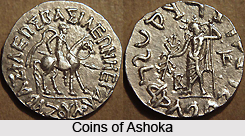 Revenue system of Mauryan Empire was devised by the prime minister of Chandragupta Maurya, Kautilya. The principal items of revenue in town and country have been listed by Kautilya while describing the duties of the Samaharta (collector-general). The main heads of revenue were:
Revenue system of Mauryan Empire was devised by the prime minister of Chandragupta Maurya, Kautilya. The principal items of revenue in town and country have been listed by Kautilya while describing the duties of the Samaharta (collector-general). The main heads of revenue were:
* a share of land output;
* Other dues and cesses levied on land including a water-rate. The water rate varied according to the nature of the land and crop and tax on houses in towns.
* income from crown lands, from forests, from mines and manufactures, some of them monopolies like salt, undertaken by government
* customs at the frontiers and tariffs, tolls and ferry dues in the interior levied on merchandise in transport
* profits of coinage and gains from trade operations carried on by the government
* fees for licenses of various kinds to be taken out by artisans, craftsmen, professionals and traders
* fines levied in law courts and
* Miscellaneous receipts like presents like transferred possession.
In emergency `benevolences` were resorted to and the rich had to pay considerable amounts to the state under. Mauryas introduced images with a view to gain gold. Granting exemptions from payment of revenue was common particularly land-revenue to Brahmins and religious institutions and to state-officials. A register of such remissions and assignments was maintained.
Industries were taxed, using a vast mix of techniques, all of which were derived from the original land revenue tax system. This entire system was the creation of Kautilya, the prime minister of Chandragupta Maurya. As the taxation system developed the government had money to further develop the kingdom. The government also introduced state owned farms where the king owned the land and his subjects were employed for its cultivation. The government had the resources to organize the procedure and once the land was ready it would employ the cultivator to work on the land.
The Mauryas had developed extensive trade relations. There were many foreign traders who took up residence in Mauryan cities. There were a variety of goods being exported thereby generating revenue. The exports were items of luxury like fine muslin cloth. The development of trade became profitable for the empire and eventually a separate department looked after trade and commerce.
Land revenue of Mauryan Empire
 Land revenues from the rural areas were appropriated in the form of crown lands (sita), land revenue (bhaga) from cultivators, taxes on orchards, ferry charges and so on. Different types of taxes that were imposed on rural population are:
Land revenues from the rural areas were appropriated in the form of crown lands (sita), land revenue (bhaga) from cultivators, taxes on orchards, ferry charges and so on. Different types of taxes that were imposed on rural population are:
(i) Bhaga - It was levied at the rate of one-fourth to one-sixth. Sharecroppers and other agricultural support by the state had to pay half of the produce to the state.
(ii) Pindikara - It was a tax levied on groups of villages and paid by farmers. This was customary. Often the villages were supposed to supply provisions to the royal army when they pass through their respective territories.
(iii) Hiranya - It was a tax paid in cash.
(iv) Bali - This was popular in the Vedic times and continued under the Mauryas.
(v) Pranaya - This literally means a gift of affection. It was levied imposed by the state during emergency. This was first mentioned by Panini, it was elaborated upon for the first time in Arthashastra. Pranaya amounted to one-third or one-fourth of the produce according to the nature of the soil.
Import tax was 20 per cent but there is no exact knowledge about the export tax. Import tax was called prabeshya and export tax was called nishkramya.
The Sulkadhyaksha or sales tax was collected on every item before it was sold or purchased. There were three rates of sale tax: 9.5 per cent on items sold on the basis of calculation; 5 per cent on the items sold on the basis of measurement; and 6.5 per cent on items sold on the basis of weight.
The following taxes were imposed in cities: (i) wine manufacturing tax; (ii) salt manufacturing tax; (iii) taxes on ghee, oil and edible oil; (iv) taxes on animal slaughterers; (v) taxes on artisans and artists; (vi) taxes on gamblers and gambling houses; (vii) taxes on prostitution, (viii) taxes on the income of temples; and (ix) taxes on additional incomes of the wage earners.



















